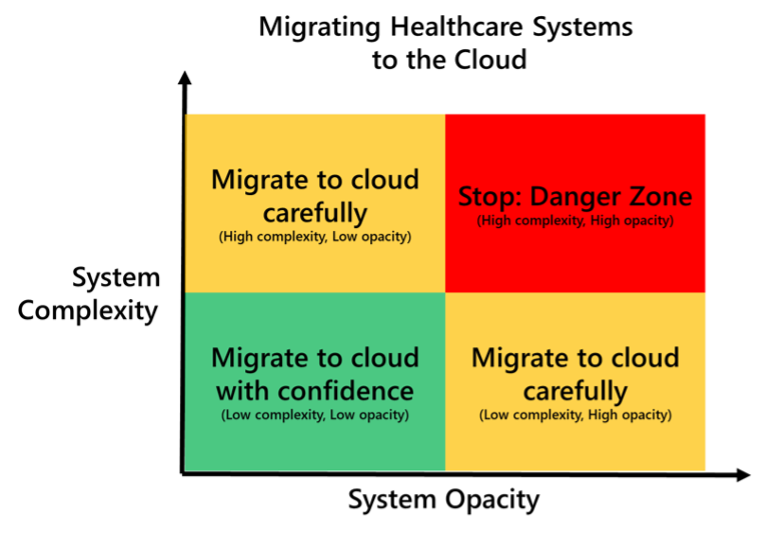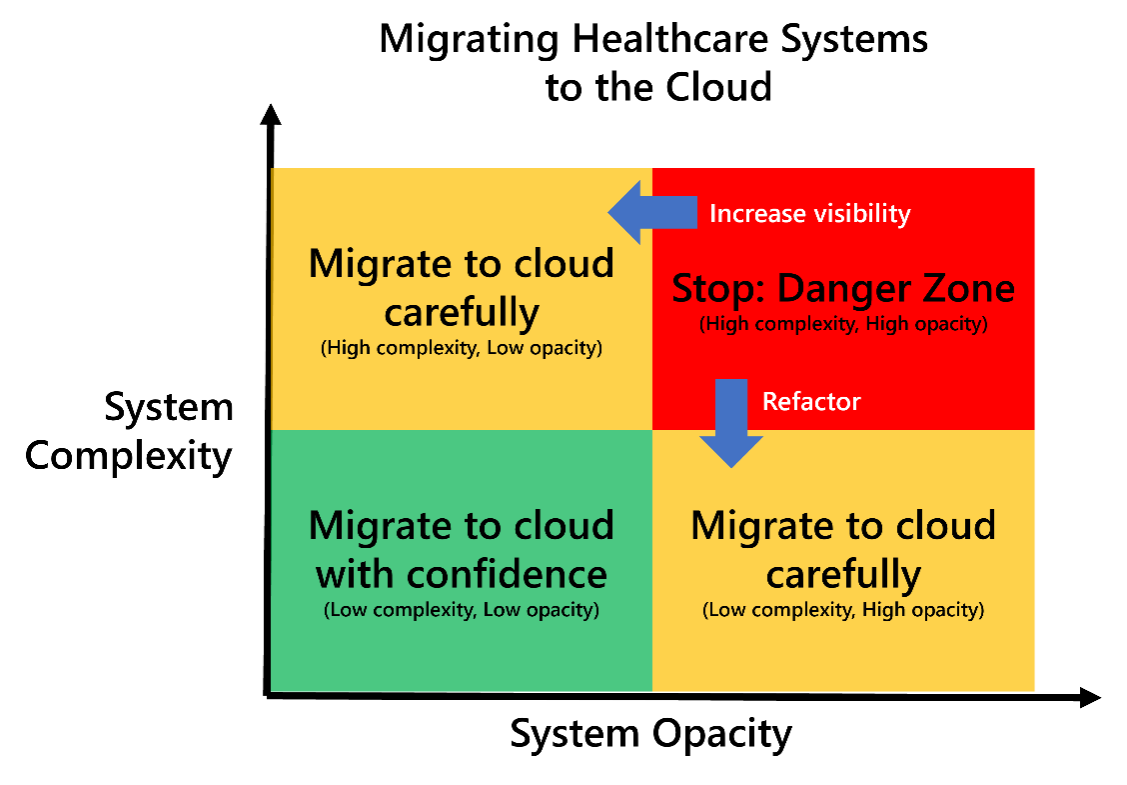Is Visibility the Key to Unlocking the Cloud in Healthcare?
Monitoring and analyzing traffic data is a key step toward accelerating digital transformation in a complex industry.

Authored by Colin Hung, Chief Marketing Officer and Editor, Healthcare IT Today
Compared with other industries, healthcare has been slower to migrate to the cloud. To assume this is because of fear, a lack of will, or insufficient resources would be disingenuous. Instead, the slow progress may be due to healthcare IT systems’ complex and opaque nature. Real-time visibility into those systems may therefore be the key to unlocking the cloud in healthcare.
System Complexity
Healthcare organizations are incredibly complex. The clinicians that care for patients depend on applications that rely on technology infrastructure that must be maintained by staff who follow specific workflows. That’s a lot of interdependencies between people, workflows, and IT systems.
There are very few industries with as many overlapping and interdependent IT systems as healthcare. Every healthcare organization has a myriad of applications that have been layered on top of one another over the years. There is rarely any documentation of how applications interact with the organization’s technology infrastructure and other applications.
It is my belief that system complexity coupled with the lack of understanding of how those systems interact (aka degree of opacity) is one of the biggest impediments to the adoption of the cloud in healthcare.
Consider the first “Migrating Healthcare Systems to the Cloud” diagram included here:

Most clinical applications fall into the danger zone that diagram illustrates—highly complex (a lot of interdependencies and connections) and highly opaque (not well understood in the context of other applications). Therefore, it is not surprising that healthcare IT leaders have not pushed to migrate these applications to the cloud.
Instead, they have focused on applications in the green zone, which in healthcare means applications such as HR, payroll, building maintenance, marketing automation, project management, and help desk. These systems have fewer connections and are better understood, making them better candidates for migrating to the cloud.
To move applications out of the danger zone (or perhaps it should be called the reluctance or hesitant zone), IT leaders can:
- Decrease the application’s complexity by refactoring or simplifying it
- Decrease the application’s opacity by better understanding its interdependencies and connections to other systems—in other words, increasing the visibility into the application and service delivery
Consider the second “Migrating Healthcare Systems to the Cloud” diagram:

System Visibility
System visibility is a core theme that runs through the recent NETSCOUT white paper “Securely Transition to the Cloud with AWS in Three Intelligent, Repeatable Steps.”
In all three steps outlined in the paper, the importance of system visibility is highlighted.
- In Step 1: Laying the Groundwork, visibility is critical to building a complete understanding of existing applications so that it is clear which workloads can be migrated as lift-and-shift versus refactor.
- In Step 2: Transition to the Cloud, visibility across a hybrid cloud environment is vital to ensuring the performance and security of the new cloud-based applications and existing on-premises ones.
- In Step 3: Deploying and Operating Cloud Services, visibility is needed to help optimize systems to improve clinician and patient experience and investigate vulnerabilities and threats.
Traffic Data
In the white paper, NETSCOUT offers an ingenious way to achieve system visibility: by analyzing traffic data. This type of data “represents every action and transaction in the infrastructure” and is a “robust data source” that can “guide the migration” to the cloud, as the paper explains.
In the first step to cloud migration, for example, traffic data could be used to build an accurate map of hospital systems that includes how systems are interconnected. Systems found to have a low degree of interconnectedness (aka complexity) could become prime targets for early migration to the cloud.
During the cloud migration, traffic data can be useful in determining whether the newly migrated application has been properly reconnected to existing systems that were dependent on it. The metadata derived from traffic data could also be used to ensure that the information flowing between on premises and the cloud is being transferred securely.
Monitoring traffic data in a hybrid cloud environment can be challenging without good instrumentation and close partnership with your cloud service provider. NETSCOUT makes things easier for healthcare organizations via a deep partnership with Amazon Web Services (AWS), the popular cloud platform, and solutions where AWS provides NETSCOUT access to its traffic data via Amazon Virtual Private Cloud (VPC) Traffic Mirroring. The capability optimizes sharing of traffic data between the two companies—key for identifying service delivery and security issues, ensuring smooth IT operations, and reducing risk.
After the migration is complete, traffic data can help maintain clinical and patient experience. Nothing erodes trust in a new system more than performance issues do. If an application performs worse than before or in unexpected ways after migrating to the cloud, it will sap energy from the organization, and future cloud migrations may become more difficult.
Visibility Is Key to Unlocking the Cloud
It is important to note that system visibility means more than traffic data. That data is just one of many ways to gain visibility. To improve visibility, organizations will need tooling and instrumentation. NETSCOUT provides a wide array of solutions designed to give organizations the end-to-end visibility they need spanning on-premises, cloud, and network edge systems.
I believe that visibility is a key to unlocking the cloud value and accelerating digital transformation with confidence. With visibility into their internal systems, IT leaders at healthcare organizations can make rational, evidenced-based decisions. What was nebulous and unknown before can suddenly become clear. That clarity leads to prudent decision-making and is critical for cloud migrations.
Practical Advice
After reading the NETSCOUT white paper, I was struck by the level of practical advice for healthcare organizations. There are many articles and papers out there on this topic, but this one stood out because it goes beyond the simple platitudes of “cloud is better for healthcare” and “migrating to the cloud takes planning.” Inside are pragmatic steps to building a complete understanding of a hospital’s systems pre-, during, and post-migration to the cloud.
If there was any doubt that healthcare is moving (albeit still gradually) to the cloud, David Chou, a seasoned healthcare technology executive and honorary member of the IEEE Computer Society, has a quote in the NETSCOUT white paper that neatly summarizes healthcare’s direction: “People do not want to buy infrastructure anymore, nor should they. They want everything to function with the ease and simplicity of the internet. That’s where the trend is heading.”
Read the white paper “Securely Transition to the Cloud with AWS in Three Intelligent, Repeatable Steps”
Colin Hung is the chief marketing officer and editor at Healthcare IT Today, where he writes regularly and manages the HITMC Community. He is also a healthcare advisor at ventureLAB and Haltech, where he has helped more than 100 healthcare entrepreneurs commercialize and scale their solutions.
Hung has been published in the Journal of the American College of Radiology and the Journal of Health Care Risk Management. He founded one of the most popular healthcare communities (HCLDR), is active on social media, and is a proud member of both #TheWalkingGallery and #pinksocks